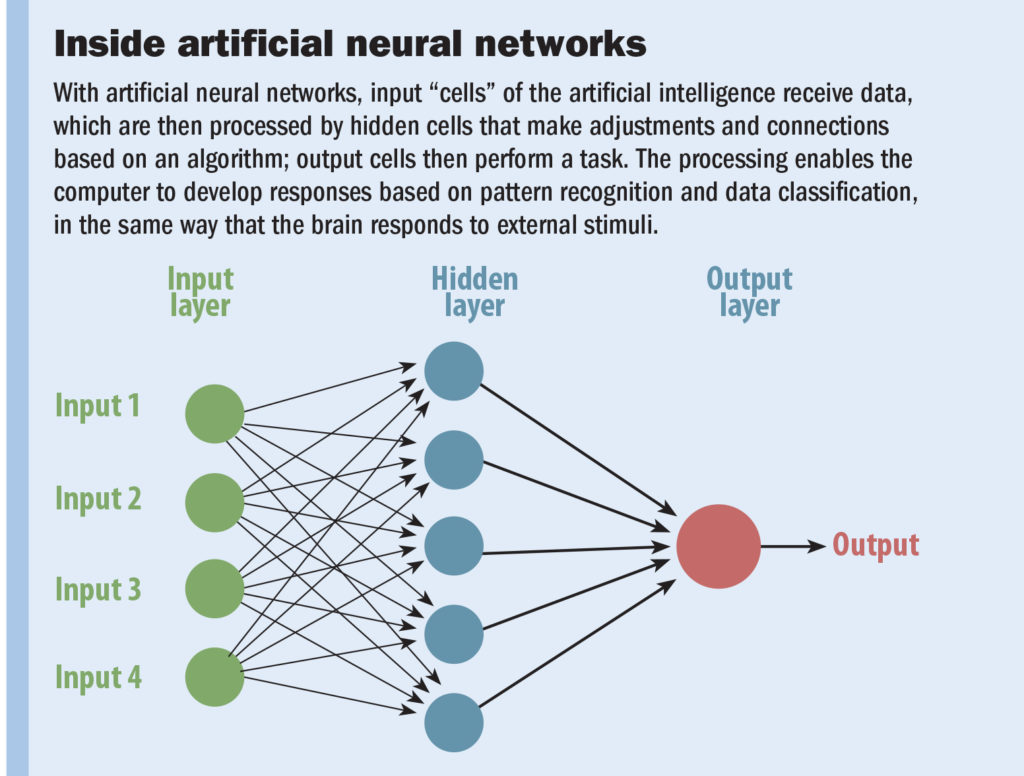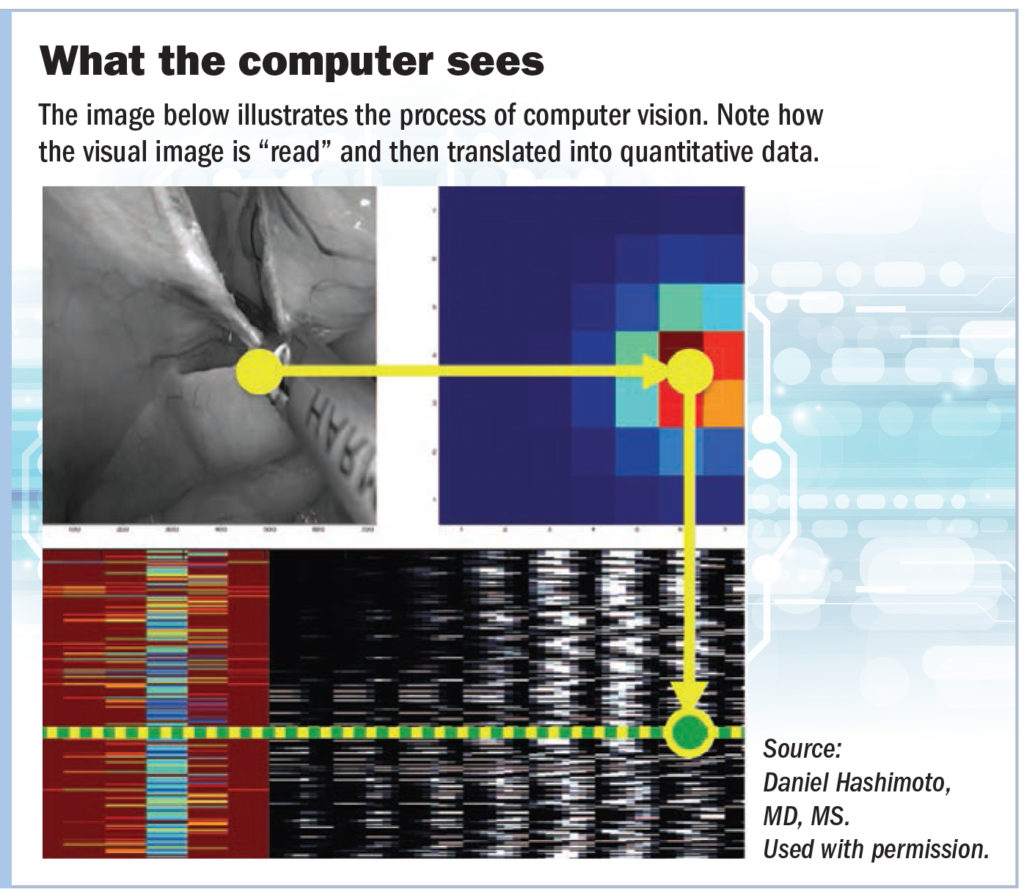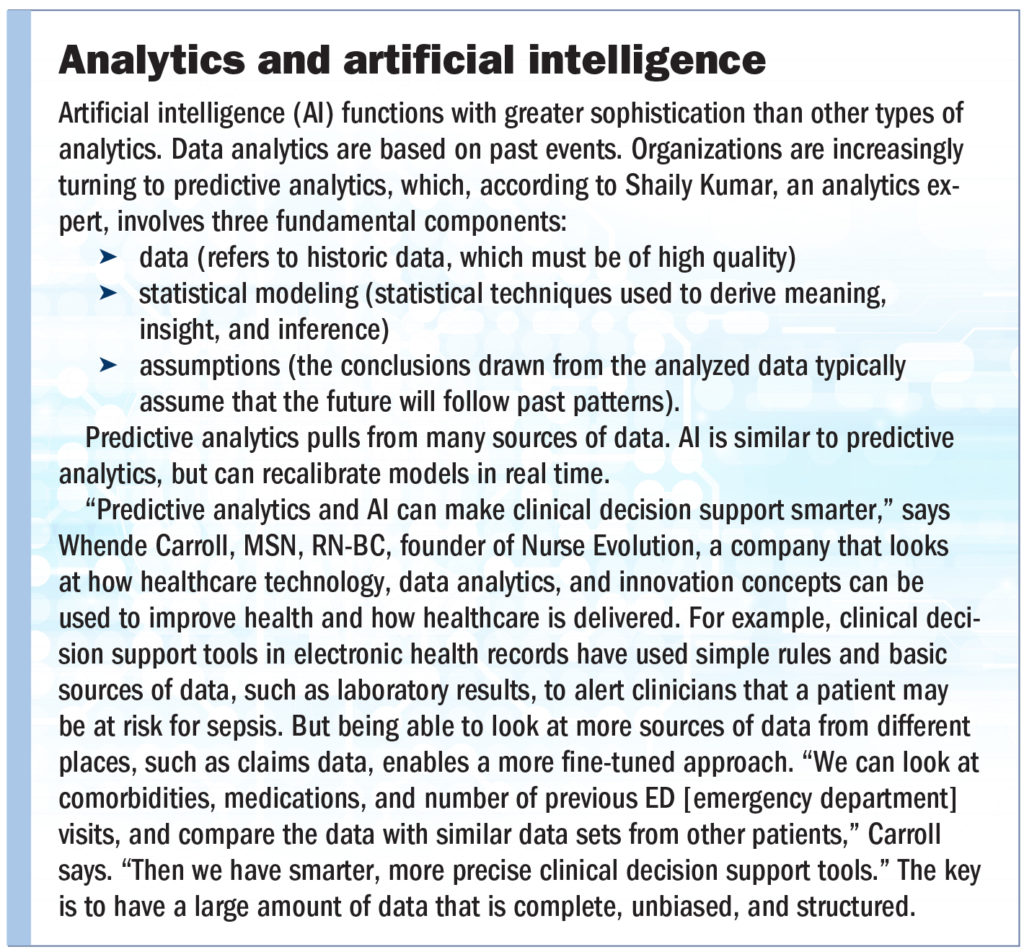Artificial intelligence (AI) may be coming to your OR sooner than you think. AI is already being used to identify areas needing quality improvement by analyzing surgical workflow, communication patterns, and errors that went unnoticed during a procedure.
OR leaders need to understand AI and participate in its development and application so that patients and organizations can reap the most benefits. In a series of articles, OR Manager will explore how AI is being used for training, practice change, improving clinical outcomes, and much more. We'll also delve into the legal, ethical, and regulatory ramifications of AI and discuss questions OR leaders should ask when considering a product marketed as having AI.
Our series begins with this two-part article, which describes the basics of AI and provides an overview of its use in surgery.
More questions than answers
AI programs include:
• the Predictive OpTimization Trees in Emergency Surgery Risk (POTTER) calculator, which uses AI to assess a patient's risk for death and 17 postoperative complications
• the Smart Tissue Anastomosis Robot (STAR), which sutures better than expert surgeons (although its use has been limited to animals)
• the DASH Analytics High-Definition Care Platform, which predicts risk of surgical site infections (SSIs) and suggests ways to reduce them in real time, as the surgeon is closing. The platform reduced SSIs by 74% in 3 years at the University of Iowa Hospitals & Clinics.
Like any new technology, the promise of AI has to be tempered with reality. Many legal and ethical questions–such as who is responsible when the AI device is wrong and how to manage the massive amounts of high-quality data required for developing AI programs–have yet to be answered. It also remains unclear where AI is most effective and how it fits into the existing healthcare culture.
"AI is not a magic bullet that fixes every problem," says Daniel Hashimoto, MD, MS, surgical artificial intelligence and innovation fellow at Massachusetts General Hospital in Boston. "When these exciting new technologies that have a lot of potential come out, there's a tendency to let the hype get ahead of the reality." He adds that AI is still relatively in its infancy as far as applications to healthcare.
That may be true, but AI is growing up fast, outpacing Moore's Law, the prediction by Intel co-founder Gordon Moore in 1965 that processing power would double every 2 years. A report from Accenture noted that the healthcare AI market would grow by 11 times from 2014 to 2021 and surpass $6.6 billion by 2021. And the Cleveland Clinic ranked AI as number two on its list of top 10 medical innovations for 2019, noting applications in decision support, image analysis, and patient triage. Innovation in robotic surgery landed in eighth place.
What is AI?
AI is the ability of a computer to respond and act in ways similar to humans. "The computer is able to perceive, think, plan, learn, and manipulate objects," says Whende Carroll, MSN, RN-BC, founder of Nurse Evolution, a company that looks at how healthcare technology, data analytics, and innovation concepts can be used to improve health and how healthcare is delivered.
"The backbone of AI is the algorithm," says Carroll, senior editor of the Online Journal of Nursing Informatics and author of an upcoming book on emerging technologies, including AI. But AI algorithms differ from those clinicians are accustomed to.
Clinical algorithms consist of a sequence of instructions that are used to complete a task, such as resuscitating a person in cardiac arrest. "In AI, an algorithm is a well-constructed set of rules given to a program, whether it's used to predict a diagnosis or chronic disease progression, or a medical device such as a robot," Carroll says. "It's the rules a machine is given so that it can plan, learn, or be able to move something."
AI isn't a new concept. John McCarthy first coined the term in 1956 at the Dartmouth Summer Research Project on Artificial Intelligence. John Glaser, PhD, senior vice president of population health at Cerner in Kansas City, Missouri, says AI has recently come into its own because it now has an "ecosystem" to support it. That ecosystem includes more powerful computer processing power and maturity of business models.
"Organizations are starting to understand how to leverage AI to improve their products and make them more competitive," Glaser says. He adds that the vast amounts of data currently available from a variety of sources have created a demand for technology that helps in understanding the implications of that data.
Types of AI
AI is an umbrella term with several other terms sheltering under it.
Machine learning (ML)
ML enables machines to learn from experience, just as humans do. That learning depends on tensors, which are clusters of data similar to the neural networks in humans. The development of programs such as TensorFlow has made it easier to write neural network software so that it provides useful information.
For example, ML has been used to enable a computer to predict bispectral index based on the infusion rates of propofol and remifentanil–and to predict it more accurately than traditional models of pharmacokinetics.
ML enables computers to make predictions by recognizing patterns; it can identify even subtle patterns when given a large database. Some people incorrectly use ML as an equivalent for AI, but not all AI is ML.
ML can be supervised or unsupervised.
Supervised learning. This focuses on training a machine to predict a known result or outcome. For example, feeding large amounts of labeled human data on what a stroke looks like on a CT angiogram will train the computer to recognize a stroke. The product Viz.ai does precisely that–it identifies suspected large vessel occlusion strokes when given a patient's angiogram. If evidence of stroke is found, it then notifies the stroke team.
The program has significant clinical implications. "Let's say you have a patient with a suspected stroke in a very small hospital with not a lot of experience with stroke," says Ferdinand Hui, MD, associate professor of radiology and radiologic science, director of interventional stroke, and codirector of the Radiology Artificial Intelligence Lab at Johns Hopkins in Baltimore. "It takes time to think and to get and interpret the imaging."
With Viz.ai, interpretation is faster. The program also notifies the radiologist and physicians caring for the patient of the results and the location of the closest stroke center. "This can shorten time to treatment significantly," Dr Hui says.
Unsupervised learning. This involves looking at unlabeled data to detect patterns or structure. For example, a machine can be taught to identify bleeding from nonbleeding tissue. This could help with early identification of abnormal bleeding during a laparoscopic procedure. "[Unsupervised learning] allows the algorithm to weigh its performance and [make] decisions more freely," Dr Hui says. He notes that AlphaGo, a computer program developed by DeepMind (part of Alphabet, Inc, the parent company of Google) to play the game Go, uses unsupervised learning. AlphaGo defeated a highly regarded Go world champion.
Reinforcement learning. This is a third category of ML that falls somewhere between supervised and unsupervised learning. In this case, the machine learns based on its ability to maximize an established reward. In essence, the machine tries to accomplish a task, such as coming to a medical decision, while learning from its own successes. Controlling an artificial pancreas system is an example of reinforcement learning in action.
Artificial neural networks (ANNs)
 ANNs process signals in a way similar to what occurs in humans (sidebar at right). A 2016 study by Monsalve-Torra and colleagues found that ANNs could analyze data such as patient history, blood pressure, and medications to help predict in-hospital mortality after open repair of an abdominal aortic aneurysm with an accuracy of 95.4%. And a 2018 study by Lee and colleagues used an ANN and intraoperative electronic medical record data to help predict in-hospital mortality of patients who underwent a variety of surgical procedures.
ANNs process signals in a way similar to what occurs in humans (sidebar at right). A 2016 study by Monsalve-Torra and colleagues found that ANNs could analyze data such as patient history, blood pressure, and medications to help predict in-hospital mortality after open repair of an abdominal aortic aneurysm with an accuracy of 95.4%. And a 2018 study by Lee and colleagues used an ANN and intraoperative electronic medical record data to help predict in-hospital mortality of patients who underwent a variety of surgical procedures.
It's worth noting that a neural network only learns what it is told to learn–at least at this stage of AI development. Gambus and Shafter say humans use their knowledge to extrapolate and apply what they know to new situations. Neural networks have to be fed large amounts of data until extrapolation isn't necessary.
Deep learning refers to a neural network that has a hierarchy of layers, with each layer transforming the input data into more abstract representations. This type of neural network is more complex than ANN, so it can learn more complex features. However, large amounts of data are needed for learning.
Natural language processing (NLP)
NLP focuses on building a computer's ability to understand human language. NLP lets the machine infer meaning from unstructured data such as providers' comments in the electronic health record (EHR). In a 2016 study by Soguero-Ruiz and colleagues, NLP enabled the computer to scan EHRs to identify words and phrases in operative reports and progress notes that predicted anastomotic leak after colorectal resections and was ultimately able to predict leaks with a sensitivity of 100% and a specificity of 72%. "Being able to process unstructured language also helps identify social determinants, so we can better care for patients," Carroll says.
Computer vision (CV)
 CV enables machines to learn from images and videos that are fed into them. CV is being used for analysis of patient cohorts, longitudinal studies, and decision-making in surgery.
CV enables machines to learn from images and videos that are fed into them. CV is being used for analysis of patient cohorts, longitudinal studies, and decision-making in surgery.
"We used video data and AI to build a model that identified with 93% accuracy the steps of a sleeve gastrectomy procedure in real time, noting any missing or unexpected steps," Dr Hashimoto says. Instead of manually evaluating videos of procedures, he and his team trained a computer to classify segments of the videos into operative steps. Deviation from the expected operative path identifies possible undesirable events (sidebar at right).
The ultimate goal is to be able to warn surgeons of missing or unexpected steps in real time, so that an adverse event can be avoided. "AI can learn from hundreds or thousands of surgical procedures simultaneously, but a surgeon learns from one surgery at a time," Dr Hashimoto says.
 AI also taps into the power of data analytics (sidebar at right).
AI also taps into the power of data analytics (sidebar at right).
A booming market
The healthcare AI market is expected to grow from $2.1 billion in 2018 to $36.1 billion by 2025. Allied Market Research predicts that the global healthcare AI market will reach $22,790 million by 2023, up from $1,441 million in 2016, with a compound annual growth rate of 48.7% from 2017 to 2023.
Big companies are taking a big interest in AI. IBM, Microsoft, Google, LinkedIn, Facebook, Intel, and Fujitsu were the seven biggest machine learning patent producers in 2017, according to IFI Claims Patient Services. EY, a consulting firm, reported that more than 300 healthcare patents were filed between 2013 and 2017: 186 by Alphabet, 73 by Microsoft, and 54 by Apple.
What will be the impact of large companies entering the AI market? Could it have a dampening effect on smaller, entrepreneurial companies that might be developing more innovative products?
"Certainly the resources and the technologic infrastructure that these larger public companies bring may pose some competitive challenges to the smaller companies," says John Beard, MD, MBA, medical director at ICU Medical, Inc, in San Clemente, California. Smaller companies may compete with larger companies or be acquired by them.
"Those companies that are really delivering the value are going to succeed," Dr Beard says. He expects that within the next 5 years, there will be a consolidation in the market, with some companies becoming known as the best providers of AI resources. Glaser says that an upside of the involvement of "tech giants" is that they will help advance the methods needed for AI, such as ML techniques.
Hospitals are already leveraging AI for competitive advantage. According to a report in Health IT News, Carolinas HealthCare is developing self-service applications that provide tools patients can use for self-diagnosis and self-treatment in selected scenarios. Leaders there hope AI will help capture additional patient information for their databases.
Payers are also jumping into AI. A 2018 article in Healthcare Finance noted that insurers are using AI to better assess patient risk so that proactive wellness actions can be taken. AI can also be used to better establish premiums and to reduce time and costs associated with manual health record reviews.
What effect will AI have on overall healthcare costs? Dr Beard believes it will lower costs. "AI will help us manage massive amounts of data that humans are not capable of investigating and analyzing in the same way," he says. For example, a complex patient scheduled for surgery may have a plethora of test results dating back years, along with medication history and comorbidities, making it time-consuming for clinicians to create a full picture of that person.
"AI can take all these disparate sources of data and filter them in a way to provide the clinically meaningful components almost in a dashboard type view of a patient," Dr Beard says, adding that each provider would have access to the data. "That saves a tremendous amount of time and human resources, and also provides improved data for decision making in matching that patient to the right treatment." Treating the patient more promptly and more effectively will reduce costs.
Many agree with Dr Beard's assessment. A 2016 report from Frost & Sullivan estimated that AI had the potential to improve outcomes by 30% to 40% while reducing treatment costs by as much as 50%. The 2018 OptumIQ Annual Survey of 500 senior healthcare leaders from health plans, hospitals, life sciences organizations, and employers found that 97% agree that AI is "the most reliable path toward equitable, accessible, and affordable healthcare."
Nearly half (47%) of hospitals are in the early stages of implementing AI, with 88% of hospital leaders confident or somewhat confident they would see a return on investment for AI, although they believe it will take 3 to 5 years.
The top health AI application in terms of value is robot-assisted surgery, according to the Accenture report, which states that health applications may potentially result in a $150 billion annual savings for the US healthcare economy in 2026.
But the authors of a 2019 opinion piece for JAMA argue that it's unclear whether AI will significantly reduce costs because of its needs for data storage, data curation, model maintenance and updating, and data visualization. "These tools and related needs may simply replace current costs with different, and potentially higher, costs," they say.
Into the OR
The booming AI market makes it likely that OR leaders will be increasingly likely to encounter AI in the OR. Part 2 of this introduction will give leaders an overview of the many current and potential surgical applications of AI. ✥
Cynthia Saver, MS, RN, is president of CLS Development, Inc, Columbia, Maryland, which provides editorial services to healthcare publications.
References
Accenture. Artificial intelligence: Healthcare's new nervous system. 2018. https://www.accenture.com/us-en/insight-artificial-intelligence-healthcare.
Allied Market Research. Artificial Intelligence in Healthcare Market by Offering (Hardware, Software, and Services), Algorithm (Deep Learning, Querying Method, Natural Language Processing, and Context Aware Processing), Application (Robot-assisted Surgery, Virtual Nursing Assistant, Administrative Workflow Assistance, Fraud Detection, Dosage Error Reduction, Clinical Trial Participant Identifier, Preliminary Diagnosis, and Others), and End User (Healthcare Provider, Pharmaceutical & Biotechnology Company, Patient, and Payer)–Global Opportunity Analysis and Industry Forecast, 2017-2023. 2018. https://www.alliedmarketresearch.com/artificial-intelligence-in-healthcare-market.
Cleveland Clinic. Cleveland Clinic unveils top 10 medical innovations for 2019. 2018. https://newsroom.clevelandclinic.org/2018/10/24/cleveland-clinic-unveils-top-10-medical-innovations-for-2019/.
EY. Life Sciences 4.0: Securing value through data-driven platforms. 2018. https://www.ey.com/Publication/vwLUAssets/ey-when-the-human-body-is-the-biggest-data-platform-who-will-capture-value/%24FILE/ey-when-the-human-body-is-the-biggest-data-platform-who-will-capture-value.pdf.
Frost & Sullivan. From $600 m to $6 billion, artificial intelligence systems poised for dramatic market expansion in healthcare. 2016. https://ww2.frost.com/news/press-releases/600-m-6-billion-artificial-intelligence-systems-poised-dramatic-market-expansion-healthcare.
Glaser J. Understanding artificial intelligence in healthcare. American Hospital Association. 2018. https://www.aha.org/news/insights-and-analysis/2018-01-23-understanding-artificial-intelligence-health-care.
Gambus P, Shafer S L. Artificial intelligence for everyone. Anesthesiology. 2018;128(3):431-433.
Hashimoto D A, Rosman G, Rus D, et al. Artificial intelligence in surgery: Promises and perils. Ann Surg. 2018;268(1):70-76.
IFI Claims Patient Services. 8 fast growing technologies. 2017. https://www.ificlaims.com/rankings-8-fast-growing.htm.
Kaafarani H M, Bertsimas D, Dunn J, et al. Surgical risk is simply not linear: Derivation and validation of a novel and interactive machine-learning Predictive OpTimization Trees in Emergency surgery Risk (POTTER) calculator. Abstract presented at the 2018 American Surgical Association annual meeting. http://meeting.americansurgical.org/abstracts/2018/18.cgi.
Kumar S. The differences between machine learning and predictive analytics. Digitalist Magazine. 2018. https://www.digitalistmag.com/digital-economy/2018/03/15/differences-between-machine-learning-predictive-analytics-05977121.
Lee C K, Hofer I, Gabel E, et al. Development and validation of a deep neural network model for prediction of postoperative in-hospital mortality. Anesthesiology. 2018;129:649-662.
Lee H C, Ryu H G, Chung E J, et al. Prediction of bispectral index during target-controlled infusion of propofol and remifentanil: A deep learning approach. Anesthesiology. 2018;128(3):492–501.
Maddox T M, Rumsfeld J S, Payne P R O. Questions for artificial intelligence in health care. JAMA. 2019;321(1):31-32.
Miliard M. Use your words! Sorting through the confusing terminology of artificial intelligence. Healthcare IT News. 2018. https://www.healthcareitnews.com/news/use-your-words-sorting-through-confusing-terminology-artificial-intelligence.
Monsalve-Torra A, Ruiz-Fernandez D, Marin-Alonso O, et al. Using machine learning methods for predicting in hospital mortality in patients undergoing open repair of abdominal aortic aneurysm. J Biomed Inform. 2016;62:195-201.
Morse S. How health insurance companies use AI to make consumers healthier. Healthcare Finance. 2018. https://www.healthcarefinancenews.com/news/how-health-insurance-companies-use-ai-make-consumers-healthier.
ReportLinker. Artificial intelligence in healthcare market by offering technology, end-use application, end user and geography–Global forecast to 2025. https://www.reportlinker.com/p04897122/Artificial-Intelligence-in-Healthcare-Market-by-Offering-Technology-Application-End-User-Industry-and-Geography-Global-Forecast-to.html.
Shademan A, Decker R S, Opfermann J D, et al. Supervised autonomous robotic soft tissue surgery. Sci Transl Med. 2016;337:337ra64.
Siwicki B. Machine learning helps UI Health Care reduce surgical site infection by 74%, save $1.2 million. Healthcare IT News. 2018. https://www.healthcareitnews.com/news/machine-learning-helps-ui-health-care-reduce-surgical-site-infection-74-save-12-million.
Soguero-Ruiz C, Hindberg K, Rojo-Alvarez J L. Support vector feature selection for early detection of anastomosis leakage from bag-of-words in electronic health records. IEEE J Biomed Health Inform. 2016;20(5):1404-1415.
Sullivan T. AI, machine learning will shatter Moore's Law in rapid-fire pace of innovation. Healthcare IT News. 2017. https://www.healthcareitnews.com/news/ai-machine-learning-will-shatter-moores-law-rapid-fire-pace-innovation.
Tahsildar S. What is the difference between neural networks and deep learning? Quora. 2018. https://www.quora.com/What-is-the-difference-between-Neural-Networks-and-Deep-Learning.
Wakefield Research. OptumIQ Annual Survey on AI in Health Care. 2019. https://www.healthleadersmedia.com/artificial-intelligence-health-care.




